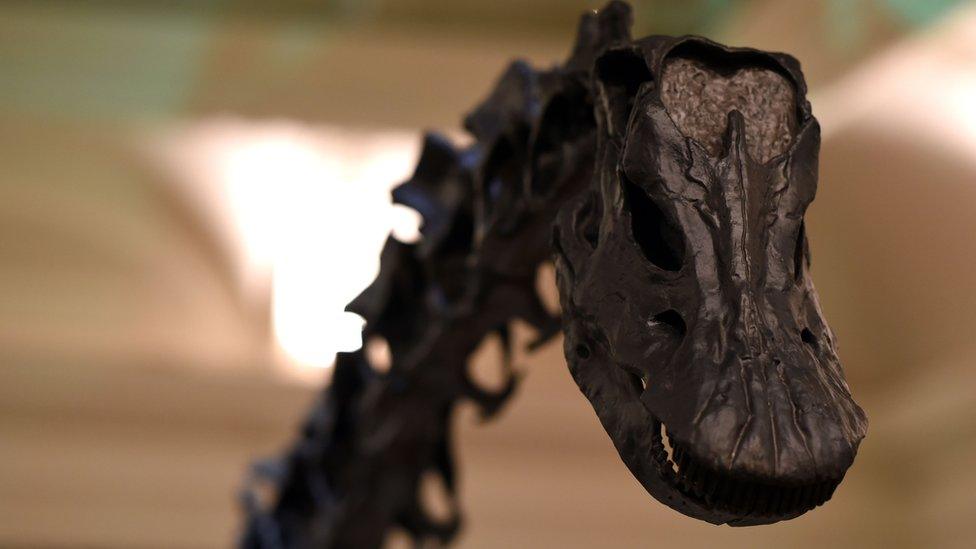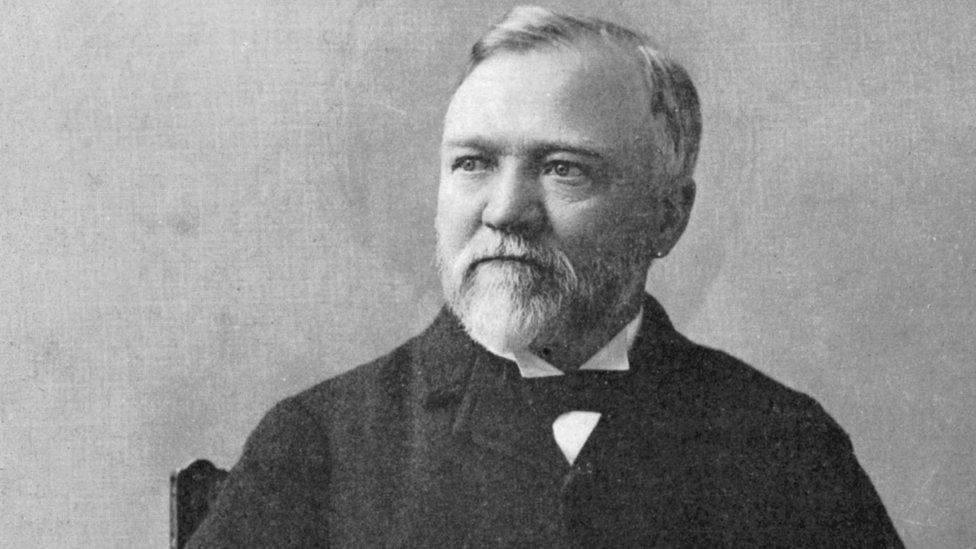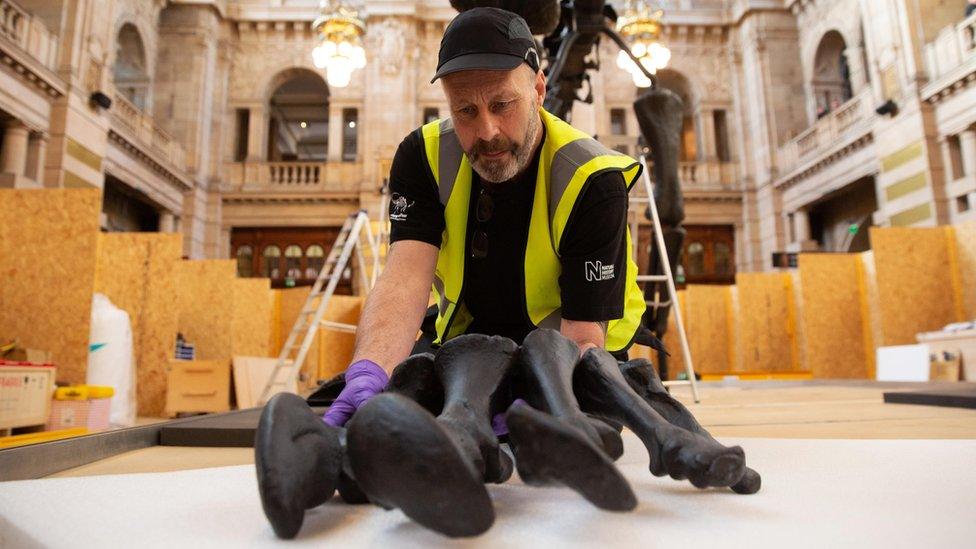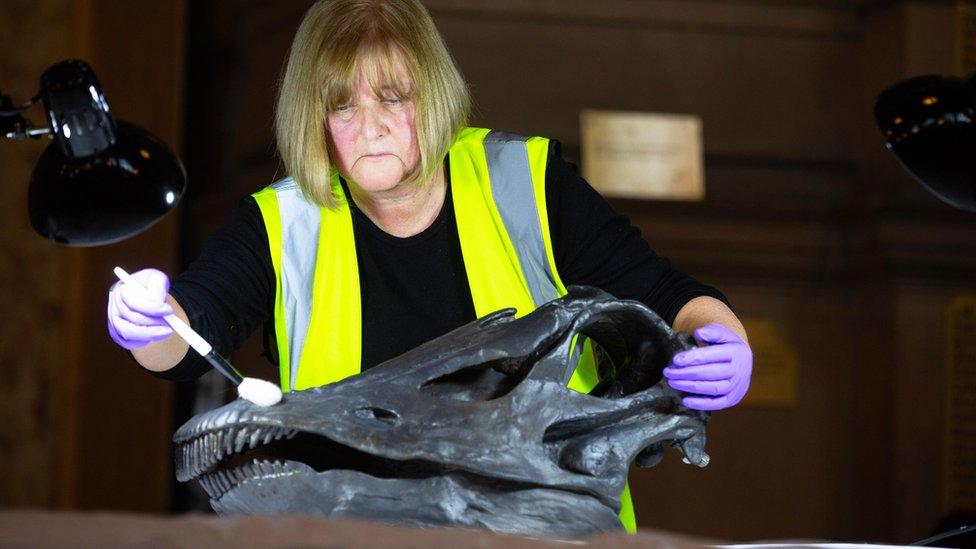Dippy the dinosaur goes on public display in Glasgow
- Published
Dippy is a replica of the original fossilised skeleton unearthed in 1899
Dippy the dinosaur has gone on public display in Scotland for the first time as part of a UK tour.
The replica diplodocus skeleton, whose home was London's Natural History Museum for 112 years, was unveiled at Glasgow's Kelvingrove Museum.
The replica is 70ft (21m) long and has 292 bones.
Dippy was commissioned by Scots-born industrialist Andrew Carnegie, who owned the original fossilised skeleton, and had a copy made from plaster.
Experts have spent five days painstakingly unpacking and assembling the dinosaur, ready for the public opening.

Dippy was on show in London's Natural History Museum for over 100 years
Prior to the UK tour, Dippy had never been on public display outside London, but has since attracted record-breaking visitors numbers for exhibitions in Birmingham and Belfast.
The skeleton arrived in Scotland from Northern Ireland in 16 special crates, with Glasgow being the tour's only Scottish stop.
Dippy will be on display until 6 May.
Natural History Museum conservator Lorraine Cornish was involved in seeing the dinosaur skeleton erected in Glasgow.
She said the Scottish leg of Dippy's tour of the UK was "a homecoming of sorts", given that Diplodocus carnegii is named after Andrew Carnegie, the Scottish steel mogul and philanthropist who financed its excavation.

Dippy's Scottish connections

Diplodocus carnegii is named after Scottish philanthropist and businessman Andrew Carnegie
Dippy, or Diplodocus carnegii to give the creature its full name, is partly named after Andrew Carnegie - the Scottish steel mogul and philanthropist who financed its excavation in Wyoming, USA in 1899.
When Carnegie heard that railroad workers had unearthed the fossilised bones of a diplodocus, he set out to acquire the bones so he could make them the centrepiece for his new museum in Pittsburgh, The Carnegie Museum of Art.
During the skeleton's reconstruction, experts discovered subtle differences from the two other diplodocus species known at the time - Diplodocus longus and Diplodocus lacustris. The new species was named Diplodocus carnegii in honour of its new owner.
When King Edward VII saw a sketch of the dinosaur while visiting Andrew Carnegie at his Scottish castle, Skibo, the conversation the men had about the sketch resulted in the commission of a replica cast, based on the original specimen in Carnegie's US museum.
The cast became known as Dippy, and was unveiled at the Natural History Museum London in 1905, where it was one of the most popular exhibits - until preparations began for Dippy on Tour in 2017.
Dippy is one of 10 replicas held in museums around the world, including Paris, Berlin, Vienna, and Moscow.

Director of the Natural History Museum, Sir Michael Dixon, said: "We are thrilled that Dippy has once again made it safely across the Irish sea and has now arrived at Kelvingrove Museum in Glasgow.
"Dippy has acted as an ambassador for the natural world, inspiring thousands of children to explore nature on their doorstep. We are sure his impact will be just as powerful in Scotland and hope visitors are as excited to see him as we are for him to be here."

The 292 bone structure was delicately unpacked by a team of specialists tasked with piecing together the iconic cast
Councillor David McDonald, chairman of Glasgow Life, said: "There is a wonderful sense of excitement surrounding the biggest thing to arrive at Kelvingrove Museum - quite literally - this year.
"We're delighted to be the only Scottish venue to host the iconic dinosaur. It feels a little like a homecoming given the conversations that led to his creation started at Skibo Castle, home of Andrew Carnegie, and it was a pleasure to have his great grandson with us for the opening."
William Thomson, Andrew Carnegie's great grandson, added: "For Andrew Carnegie, Diplodocus carnegii was more than a huge prehistoric creature. It was a symbol and an opportunity.
"By gifting copies to the heads of state of seven other countries as well as the UK, Carnegie hoped to demonstrate through mutual interest in scientific discoveries that nations have more in common than what separates them."

Dippy on Tour: A Natural History Adventure will run at Kelvingrove until 6 May
- Published9 February 2018